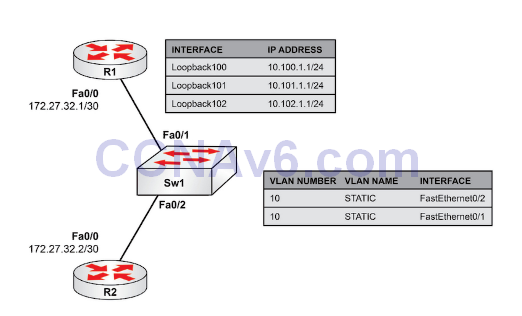Lab Objective:
The objective of this lab exercise is to configure static routes via next hop IP addresses on interfaces connected to a switch on two routers. This lab also goes through the validation of the configured static routes.
Lab Purpose:
Static route configuration is a fundamental skill. There are several methods to configure static routes on a Cisco router, and each way has its pros and cons. As a Cisco engineer, as well as in the Cisco CCNA exam, you will be expected to know how to configure static routes via any of the methods available in Cisco IOS.
Certification Level:
This lab is suitable for both CCENT and CCNA certification exam preparation.
Lab Difficulty:
This lab has a difficulty rating of 5/10.
Readiness Assessment:
When you are ready for your certification exam, you should complete this lab in no more than 15 minutes.
Lab Topology:
Please use the following topology to complete this lab exercise:

Task 1:
Configure the hostnames on R1, R2, and Sw1 as illustrated in the topology.
Task 2:
Configure Sw1 as a VTP sever and configure VLAN10 named STATIC. Assign ports FastEthernet0/1 and FastEthernet0/2 to this VLAN.
Task 3:
Configure IP addresses 172.27.32.1/30 and 172.27.32.2/30 on R1 and R2 Fa0/0 interfaces, respectively. In addition, configure the Loopback interfaces on R1 with the IP addresses in the topology.
Task 4:
Configure static routes via the next hop IP address of 172.27.32.2 on R2 to all the subnets configured on the Loopback addresses previously configured on R1. Verify your static route configuration. Ping each Loopback interface configured on R1 from R2 to validate your static route configuration.
Configuration and Verification
Task 1:
For reference information on configuring hostnames, please refer to earlier labs.
Task 2:
For reference information on configuring standard VLANs, please refer to earlier labs.
Task 3:
R1#conf t Enter configuration commands, one per line. End with CTRL/Z. R1(config)#int fast0/0 R1(config-if)#ip address 172.27.32.1 255.255.255.252 R1(config-if)#no shutdown R1(config-if)#end R2#config t Enter configuration commands, one per line. End with CTRL/Z. R2(config)#int fa0/0 R2(config-if)#ip add 172.27.32.2 255.255.255.252 R2(config-if)#no shu R2(config-if)#^Z R1#ping 172.27.32.2 Type escape sequence to abort. Sending 5, 100-byte ICMP Echos to 172.27.32.2, timeout is 2 seconds: .!!!! Success rate is 80 percent (4/5), round-trip min/avg/max = 4/4/4 ms R1#config t Enter configuration commands, one per line. End with CTRL/Z. R1(config)#int loop100 R1(config-if)#ip add 10.100.1.1 255.255.255.0 R1(config-if)#exit R1(config)#int loop101 R1(config-if)#ip add 10.101.1.1 255.255.255.0 R1(config-if)#exit R1(config)#int loop102 R1(config-if)#ip add 10.102.1.1 255.255.255.0 R1(config-if)#^Z R1# R1#sh ip int bri Interface IP-Address OK? Method Status Protocol FastEthernet0/0 172.27.32.1 YES manual up up Loopback100 10.100.1.1 YES manual up up Loopback101 10.101.1.1 YES manual up up Loopback102 10.102.1.1 YES manual up up
Task 4:
R2#conf t Enter configuration commands, one per line. End with CTRL/Z. R2(config)#ip route 10.100.1.0 255.255.255.0 172.27.32.1 R2(config)#ip route 10.101.1.0 255.255.255.0 172.27.32.1 R2(config)#ip route 10.102.1.0 255.255.255.0 172.27.32.1 R2(config)#end R2# R2#show ip route Codes: C - connected, S - static, R - RIP, M - mobile, B – BGP, D - EIGRP, EX - EIGRP external, O - OSPF, IA - OSPF inter area, N1 - OSPF NSSA external type 1, N2 - OSPF NSSA external type 2, E1 - OSPF external type 1, E2 - OSPF external type 2, i - IS-IS, su - IS-IS summary, L1 - IS-IS level-1, L2 - IS-IS level-2, ia - IS-IS inter area, * - candidate default, U - per-user static route, o - ODR, P - periodic downloaded static route Gateway of last resort is not set 172.27.0.0/30 is subnetted, 1 subnets C 172.27.32.0 is directly connected, FastEthernet0/0 10.0.0.0/24 is subnetted, 3 subnets S 10.102.1.0 [1/0] via 172.27.32.1 S 10.101.1.0 [1/0] via 172.27.32.1 S 10.100.1.0 [1/0] via 172.27.32.1 R2#ping 10.100.1.1 Type escape sequence to abort. Sending 5, 100-byte ICMP Echos to 10.100.1.1, timeout is 2 seconds: !!!!! Success rate is 100 percent (5/5), round-trip min/avg/max = 4/4/4 ms R2#ping 10.101.1.1 Type escape sequence to abort. Sending 5, 100-byte ICMP Echos to 10.101.1.1, timeout is 2 seconds: !!!!! Success rate is 100 percent (5/5), round-trip min/avg/max = 1/2/4 ms R2#ping 10.102.1.1 Type escape sequence to abort. Sending 5, 100-byte ICMP Echos to 10.102.1.1, timeout is 2 seconds: !!!!! Success rate is 100 percent (5/5), round-trip min/avg/max = 1/2/4 ms
NOTE: Notice the difference in this ping versus the one where you used an interface as the next hop for static routing. Because an IP address has been specified, there is no ARP timeout for the first packet since the next hop Layer 3 address has been specified.
